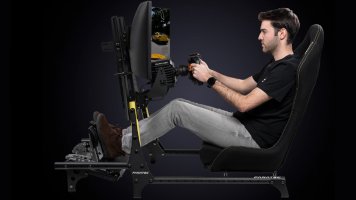Having acquired a pair to laterally stimulate a traction loss project,
Thrusters were bonded to a 3.5mm aluminum strap for seat frame installation:
.. which also allowed for more representative comparison with Dayton's puck.
First, since the strap could be firmly held against the 30mm reference surface,
the Thruster could be driven harder,
improving signal-to-noise and consistency of plots,
but also making more evident that
the 30mm reference surface is less inert than was supposed:
A high Q resonance previously noted near 60Hz is still evident,
but the broad peak around 600Hz shows this surface less damped than expected.
More surprising is relatively large response below 20Hz, which is not sensed.
Unobvious from this graph is that 25Hz energy injected by the Thruster
was sensed in a Logitech mouse half a meter distant.
Sympathetic vibrations and rattles were issues with the Thruster
that had not been with the puck, much less Visaton,
both driven with
over 10dB more power.
Here is a plot for piezo glued to Thruster body, moving in reaction to 30mm surface:
Individual sweeps, as well as average, show how consistent are results above 28Hz.
These sweeps were made with settings identical to the above sweeps,
demonstrating how much a Thruster energized the 30mm "reference" surface
above 200Hz and 9 to 30Hz. For convenient comparison, here is puck sweep result:
Since measured with different gain settings, only curve shapes are comparable,
but note that averaged puck response varies overall more smoothly about 70dB,
while averaged Thruster response varies about 36dB,
albeit with an abrupt transition between 30 and 50Hz, which can be addressed
by equalization, given how much more tactile energy Thrusters produce.
The puck seems penalized by a relatively low moving mass
less able to transfer higher frequency energy into that reference surface
(until its broad resonance starting at 300Hz) so well as can the Thruster.
Considering responses between 100Hz and 15Hz, below which neither are sensible,
the puck is +/-8dB, compared to +/-18 for the Thruster,
which has more output to equalize away, if need be.
FWIW, checked with a multimeter on initial receipt,
Thrusters have appreciably lower DC resistance
than is typical e.g. for subwoofers.
Consequently, wiring a pair in series, rather than parallel,
seems more reasonable for low frequency tactile service
as a load for conventional amplifiers.





























